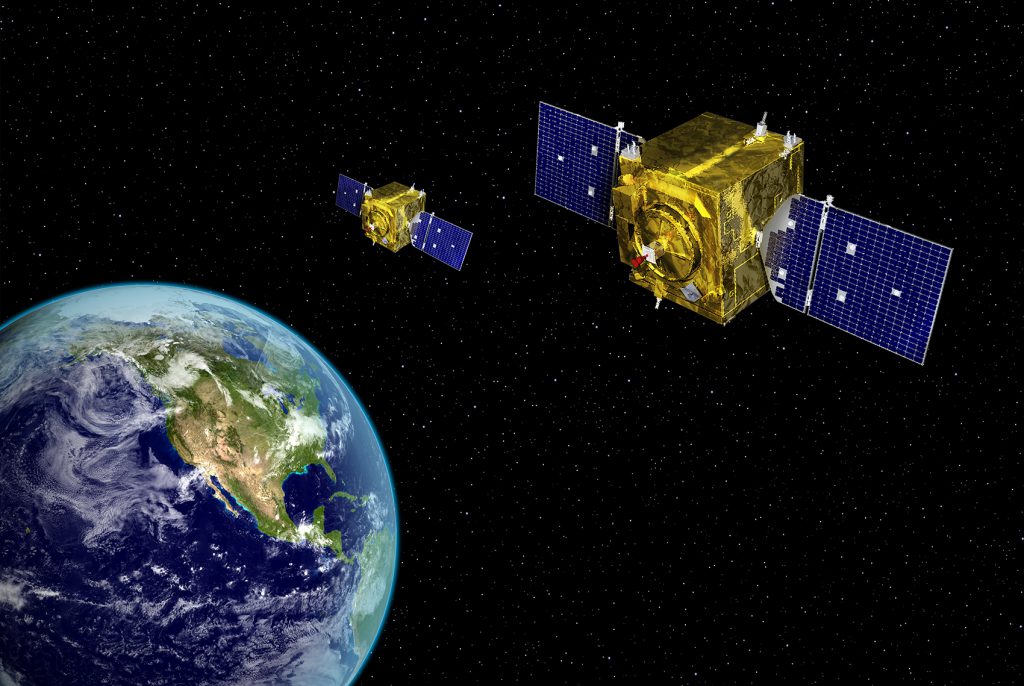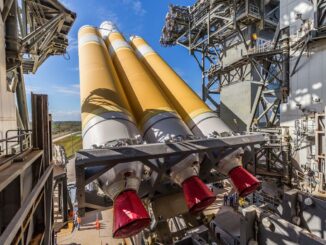
CAPE CANAVERAL — The Air Force will launch a second pair of small security probes 22,300 miles above the Earth using a Delta 4 rocket on Friday to alert ground controllers of impending space collisions and monitor potential meddling with U.S. orbiting assets.
The once-classified Geosynchronous Space Situational Awareness Program embeds its robotic informants just below and just above geosynchronous orbit to perform reconnoitering duties. The first GSSAP duo, launched in July 2014, is in use today by Strategic Command to provide the military maneuverable eyes in this critical region of space.
GSSAP No. 3 and No. 4 will be carried to the high ground Friday by a United Launch Alliance Delta 4 rocket, lifting off from Cape Canaveral on the six-hour ascent at 12:47 a.m. EDT (0447 GMT).
The day’s launch window extends 65 minutes.
Geosynchronous orbit is the valuable region where communications satellites, weather observatories, missile warning platforms and surveillance spacecraft reside because the 22,300-mile altitude enables them to match Earth’s rotation and stay locked above one area of the globe.
Some of the military’s most crucial satellites — to provide life-line communications between the president and battlefield commanders, sentinels to detect and track missile launches and eavesdropping reconnaissance craft to spy on enemies — make geosynchronous orbit a potential target for adversaries.

With that in mind, GSSAP’s existence was made known to the world that the military would field these four small satellites with maneuverability to rendezvous and perform proximity operations around geosynchronous objects.
“GSSAP utilizes its optical payload to collect data which includes location, orbit, size and status of space objects. By collecting this data, GSSAP provides an enhanced Space Situational Awareness function, improving our ability to rapidly detect, warn, characterize, and attribute disturbances to space systems in the geosynchronous environment,” the Air Force’s Space and Missile Systems Center told Spaceflight Now in response to questions about the upcoming launch.
Orbital ATK built all four GSSAP satellites for the Pentagon, but the Air Force declined to provide certain details about the program such as launch mass, dimensions of the craft, mission lifespan and cost.
“The technical specifications of the GSSAP vehicles are classified,” the Air Force says.
“Space capabilities touch every facet of our lives — they allow people and governments around the world to see with clarity, navigate with accuracy, communicate with certainty and operate with assurance. GSSAP improves our ability to rapidly detect, warn, characterize and attribute disturbances to space systems in the geosynchronous environment,” SMC told Spaceflight Now.
“This capability assists the U.S. and its allies to achieve responsible and safe use of space. By gaining more comprehensive Space Situational Awareness, we are better able to provide more robust spaceflight safety information.”
GSSAP joins ground-based sensors and low-Earth orbiting satellites in tracking man-made objects like spacecraft, rocket bodies and debris.

The Air Force won’t say if further GSSAP satellites are planned.
“Aside from GSSAP satellites 3 and 4, which are scheduled to be launched in August, there are no details available for constellation sizing.”
GSSAP relies on communications through the global Air Force Satellite Control Network ground stations. The 50th Space Wing operates the satellites from Schriever Air Force Base in Colorado.
The initial GSSAP pair has operated in various configurations to date, with one satellite below and one above the geosynchronous belt and both below, and worked closely together in tandem and also separated apart from each other to large distances, according to hobbyists who track spacecraft.
“Their small size makes them a challenge to detect, but hobbyists have observed them on occasion,” said Ted Molczan, a respected sky-watching hobbyist.
The Delta 4 launch vehicle will be flying in its Medium+ (4,2) configuration with two side-mounted solid boosters and a four-meter upper stage and nose cone. The variant can deliver about 5,115 pounds of payload directly into geosynchronous orbit.

Delta 4 uses a “classic pad” concept with a fixed umbilical tower and a moveable gantry for weather protection and worker access during the rocket’s vertical integration and checkout, lifting and attaching the solid motors and the payload, then retracts for launch. That mobile service tower will be pulled back Thursday afternoon around 5:30 p.m. as countdown operations get underway for the 375th Delta rocket launch.
Fueling of the two-stage rocket with 165,000 gallons of liquid hydrogen and liquid oxygen will begin about four hours before liftoff, giving the Delta 4 a launch mass of 720,000 pounds.
Weather forecasters predict 80 percent odds of favorable launch conditions, with only a slight worry for cumulus clouds during the overnight flight opportunity.
“Thursday evening and Friday morning, a trough moves into the southeast U.S., suppressing the Bermuda high pressure ridge into Florida. Winds will shift and become weak from the southeast, and isolated showers are possible causing a slight concern for a cumulus cloud Launch Commit Criteria violation,” Air Force launch meteorologists say.
The 206-foot-tall vehicle will power off the Complex 37B pad on 1.1 million pounds thrust from the liquid-fueled RS-68A main engine made by Aerojet Rocketdyne and the pair of solid-fuel boosters from Orbital ATK.
Arcing to the east, Delta 4 will hit Mach 1 in 44 seconds and experience maximum dynamic pressure, or Max Q, at 57 seconds.
The ground-lit boosters will burn out at 93 seconds and separate at 100 seconds, leaving the first stage engine to propel the vehicle until T+plus 3 minutes and 58 seconds.
Staging then occurs as the second stage ignites for the first of its three firings needed to reach geosynchronous orbit.

The 13-foot-wide, 39-foot-long nose cone made of composites is jettisoned at four minutes and 30 seconds, signifying the conclusion of real-time public information about the launch.
The subsequent maneuvers by the rocket to achieve a parking orbit, the movement to a highly elliptical transfer orbit and then a circularization burn all occur in secrecy.
It will be the 33rd Delta 4 rocket launch since 2002, the 18th mission for the Air Force and the 14th Medium+ (4,2) version of the vehicle to fly.
And it marks the 35th launch from Pad B at Complex 37, following 8 unmanned Saturn missions between 1964 and 1968 and 27 Delta 4s since 2002.
See earlier Delta 375 coverage.
Our Delta archive.



